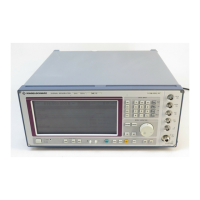Introduction/Brief Instructions SME
1038.6002.02 3.2 E-13
3.2.2 RS-232 Interface
It is assumed that the configuration of the RS-232 interface at the unit has not yet been changed.
1. Connect unit and controller using the 0-modem cable.
2. Enter the following command at the controller to configure the controller interface:
mode com1: 9600, n, 8, 1
3. Create the following ASCII file:
*RST;*CLS
FREQ 50MHz
POW -7.3dBm
OUTP:STAT ON
AM:SOUR INT1
AM:INT1:FREQ 15kHz
AM 30PCT
AM:STAT ON
Switch instrument to remote control (Return key)
Reset instrument
Set frequency 50 MHz
Set output level -7.3 dBm
Switch on RF output
Set AM modulation source LFGEN1
Set modulation frequency 15 kHz
Set AM modulation depth 30%
Switch on AM
(Return key)
4. Transfer ASCII file to unit via RS-232 interface. Enter the following command at the controller:
copy <filename> com1:
An amplitude-modulated signal is now applied at the output of the instrument.
5. To return to manual control, press the [LOCAL] key at the front panel.
3.3 Switchover to Remote Control
On power-on, the instrument is always in the manual operating state ("LOCAL"state) and can be
operated via the front panel.
The instrument is switched to remote control ("REMOTE)" state)
IEC-bus as soon as it receives an addressed command from a controller.
RS-232 as soon as it receives either a carriage return <CR> (=0Dh) or a line feed <LF> (0Ah) from
a controller.
During remote control, operation via the front panel is disabled. The instrument remains in the remote
state until it is reset to the manual state via the front panel or via IEC bus (see Sections 3.3.1.3 and
3.3.2.3). Switching from manual operation to remote control and vice versa does not affect the
remaining instrument settings.

